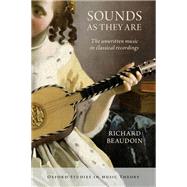Sounds as They Are The unwritten music in classical recordings
, by Beaudoin, Richard- ISBN: 9780197659281 | 0197659284
- Cover: Hardcover
- Copyright: 1/5/2024
In a recording, what sounds count as music? Sounds made by a musician's body--including inhales, finger taps, and grunts--have for decades been dismissed as extraneous noises. In Sounds as They Are: The unwritten music in classical recordings, author Richard Beaudoin pioneers a field of inquiry into non-notated sounds in recordings of classical music, recognizing often-overlooked sounds made by the bodies of performers and their recording equipment as music.
Beaudoin classifies such sounds via inclusive track analysis (ITA), a bold new theory based on a comprehensive census of audible events on a given recording, and then codifies their musical function. He builds a typology across four large categories: sounds of breath (inhaling and exhaling), sounds of touch (guitar squeaks, piano pedals), sounds of effort (grunting and moaning), and surface noise (on early recording formats). Breaths are shown to be as complex and diverse as chords. Touch sounds create empathy with listeners. Effortful vocalizations reveal connections between music-making and sex. The measurement of surface noise reveals moments of synchronization with the meter of the recorded piece. He draws analogies between unwritten music and painting, photography, poetry, psychology, and government. The book's methodology is intertwined with the aesthetics and ethics of non-notated sounds: who is allowed to make them, and how they are received by listeners, critics, and scholars. Beaudoin uncovers insidious inequalities across music studies and the recording industry, including the silencing of body and breath sounds along lines of gender and race.
Sounds as They Are demonstrates the expressive, interpretive, and embodied possibilities that emerge when all sounds are valued coequally and asks music theory to face a simple truth: that all sounds deserve recognition.
Beaudoin classifies such sounds via inclusive track analysis (ITA), a bold new theory based on a comprehensive census of audible events on a given recording, and then codifies their musical function. He builds a typology across four large categories: sounds of breath (inhaling and exhaling), sounds of touch (guitar squeaks, piano pedals), sounds of effort (grunting and moaning), and surface noise (on early recording formats). Breaths are shown to be as complex and diverse as chords. Touch sounds create empathy with listeners. Effortful vocalizations reveal connections between music-making and sex. The measurement of surface noise reveals moments of synchronization with the meter of the recorded piece. He draws analogies between unwritten music and painting, photography, poetry, psychology, and government. The book's methodology is intertwined with the aesthetics and ethics of non-notated sounds: who is allowed to make them, and how they are received by listeners, critics, and scholars. Beaudoin uncovers insidious inequalities across music studies and the recording industry, including the silencing of body and breath sounds along lines of gender and race.
Sounds as They Are demonstrates the expressive, interpretive, and embodied possibilities that emerge when all sounds are valued coequally and asks music theory to face a simple truth: that all sounds deserve recognition.






